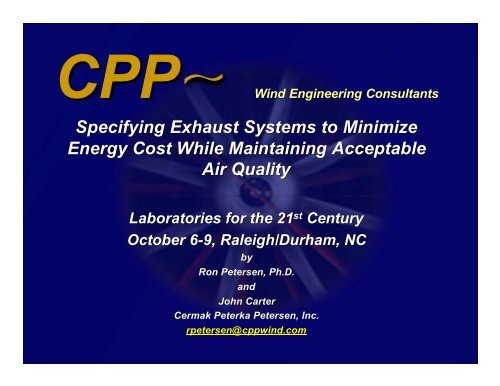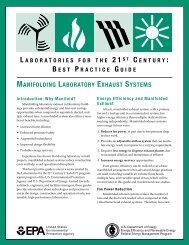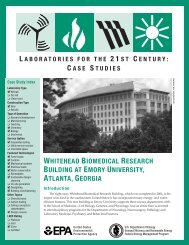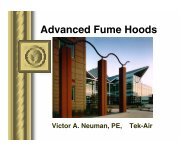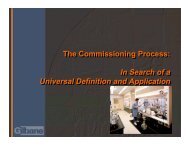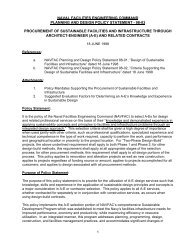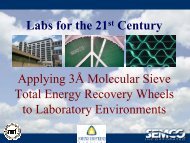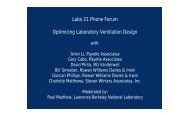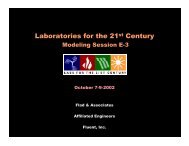CDC Building 110 CDC Building 110
CDC Building 110 CDC Building 110
CDC Building 110 CDC Building 110
You also want an ePaper? Increase the reach of your titles
YUMPU automatically turns print PDFs into web optimized ePapers that Google loves.
CPP~ ~ Wind<br />
Wind Engineering Consultants<br />
Specifying Exhaust Systems to Minimize <br />
Energy Cost While Maintaining Acceptable <br />
Air Quality<br />
Laboratories for the 21 st Century<br />
October 6-9, Raleigh/Durham, NC<br />
by<br />
Ron Petersen, Ph.D.<br />
and<br />
John Carter<br />
Cermak Peterka Petersen, Inc.<br />
rpetersen@cppwind.com
OUTLINE<br />
"Reentry of Pollutants<br />
"Specification of Acceptable Exhaust<br />
Design<br />
"Relating Energy Cost to Exhaust<br />
Design<br />
"Examples from Recent Projects<br />
{
Acceptable Air Quality & Reentry of<br />
Pollutants<br />
{
Specifying Exhaust and Intake<br />
Systems<br />
by<br />
Petersen, Cochran and Carter<br />
ASHRAE Journal, August 2002<br />
{
Plume impact on taller downwind building<br />
{
Plume impacting taller upwind building<br />
{
Specifying an Acceptable Design<br />
Identify Exhaust Sources of Concern<br />
Develop Design Criteria<br />
Concentration (or Dilution) Predictions<br />
(Numerical Modeling; Physical Modeling; Full Scale Testing)<br />
Modify Design<br />
or Criteria<br />
No<br />
Design<br />
Acceptable<br />
?<br />
Yes<br />
GOOD DESIGN<br />
{
Identify Sources of Concern<br />
Boiler<br />
Radioisotope<br />
Biosafety<br />
Cabinet<br />
&<br />
Isolation Room<br />
Chemical Fume <br />
Hood<br />
Cooling Tower<br />
Animal<br />
Room<br />
Traffic<br />
Also:<br />
• Kitchen Hood Exhaust<br />
•Ethylene Oxide (EtO)<br />
Emergency Generator<br />
Helicopter<br />
Diesel Vehicles<br />
{
Concentration Design Criteria<br />
(continued)<br />
"Health Limits (C health )<br />
"Lowest of ACGIH, OSHA and NIOSH<br />
• STELs (15 Minute Averaging Time)<br />
• 8 hr TWA multiplied by 3<br />
"Safety Factor of 5<br />
(ANSI/AIHA Z9.5 – Changing)<br />
"Odor Thresholds (C odor )<br />
"ACGIH; various research<br />
{
Concentration Design Criteria<br />
(continued)<br />
"Mass emission rates (m)(<br />
"Chemical hood emissions<br />
• EPA equation for accidental spill<br />
m T U A M V<br />
? 4 2 0 . 75<br />
? 6 . 94 x 10 ( 1 ? 0 . 0043 [ ? 27315 . ] )<br />
r<br />
V<br />
• 1 minute lecture bottle evacuation<br />
p<br />
pk<br />
{
General Design Criteria<br />
"ASHRAE Lab Handbook Chapter 13<br />
" Use 5000:1 for 1000 cfm flow<br />
"Use 400 mg/m 3 per g/s<br />
" ASHRAE <strong>110</strong> Fume Hood Testing <br />
" Use 3000:1 for 1000 cfm flow<br />
"Use 700 mg/m 3 per g/s<br />
"AM.05 Rating.<br />
{
Concentration Predictions<br />
"Analytical – may add energy cost<br />
"Computational Fluid Dynamics (CFD) –<br />
not ready for routine applications<br />
"Wind Tunnel Modeling (WT) – most<br />
accurate, best for optimizing design<br />
"See previous presentations @<br />
www.epa.gov/labs21century<br />
{
Wind Tunnel Modeling -- Like a<br />
Field Study, Controlled<br />
Meteorology, Design Changes<br />
{
Wind Tunnel Concentration<br />
Measurements at Air Intake<br />
{
Relating Energy Costs to<br />
Exhaust Design<br />
{
Exhaust Design Factors<br />
Affecting Energy Costs<br />
"Air Intake Locations<br />
"<strong>Building</strong> Design and Existing<br />
Environment<br />
"Chemical Utilization<br />
"Volume Flow/Exit Velocity<br />
"Local Meteorology<br />
{
Exhaust Evaluation Approach<br />
Air quality acceptability question:<br />
LEEDS Credit 9.1 -- Meet all standards and generally<br />
accepted guidelines C ? for ? outdoor C protection of workers<br />
and general public max from airborne health chemical, / odor radioactive<br />
and biological hazards. Use mathematical modeling, <br />
physical modeling and/or post construction testing and <br />
certification to prove compliance.<br />
{
Factors Affecting Concentration<br />
C<br />
2<br />
m<br />
H<br />
? exp[ ? ]<br />
{<br />
2<br />
? ? ? U } 2 ?<br />
y z s z<br />
x 10<br />
6<br />
1<br />
{ ? ? ?<br />
y<br />
z<br />
U<br />
s<br />
}<br />
Site and Design Effects Term<br />
m<br />
2<br />
H<br />
? exp[ ? 2 ]<br />
2?<br />
z<br />
Energy Term<br />
{
Plume Rise Predictions –<br />
Main Energy Term<br />
1/3<br />
H ~ h s + A [CFM x FPM] 1/3<br />
~ Fan Horsepower<br />
{
Entrained Air Stacks on Lab Roof<br />
{
Conventional vs. Entrained Air – 20 mph<br />
Centerline Plume Height (ft)<br />
45<br />
40<br />
35<br />
30<br />
25<br />
20<br />
15<br />
10<br />
5<br />
0<br />
0 20 40 60 80 100<br />
Downwind Distance (ft)<br />
Conventional (15,000 cfm) Entrained (25,000 cfm) Difference
Examples<br />
"<strong>CDC</strong> <strong>Building</strong> <strong>110</strong><br />
"Pomona College<br />
"Commercial Medical Research Lab<br />
{
Stack Design and Results Information<br />
Stack Volume Exit Motor Annual Design Max<br />
Source Stack Height Flow Rate Velocity Size 1 Energy Criterion Measured<br />
Description ID hs Q Ve Cost HL/m C/m<br />
(ft) (cfm) (fpm) (bhp) ($) (µg/m³)/(g/s) (µg/m³)/(g/s)<br />
<strong>CDC</strong> <strong>Building</strong> <strong>110</strong> - Laboratory<br />
Initial Specifications <strong>CDC</strong>-Lab (EAE) 21.0 60,000 3,056 52.3 $20,340 230 81<br />
Recommended Specifications <strong>CDC</strong>-Lab (CE) 21.0 30,000 1,528 25.9 $10,054 230 162<br />
<strong>CDC</strong> <strong>Building</strong> <strong>110</strong> - Emergency Room<br />
Recommended Specifications (Conventional) 6.4 5,800 6,292<br />
Recommended Specifications (Axijet 1500) <strong>CDC</strong>-ER (EAE) 6.4 8,210 3,898 6.9 $2,683 230 236<br />
Equivalent Recommended Specifications (Conventional) <strong>CDC</strong>-ER (CE) 6.4 10,606 3,000 8.8 $3,404 230 259<br />
Pomona College NBB - Laboratory<br />
Initial Specification (Axijet 3650) PC-Lab (EAE) 12.9 24,000 3,876 15.6 $6,083 400 Not Tested<br />
Recommended Specifications (Conventional) PC-Lab (CE) 10.0 15,000 3,000 12.6 $4,910 400 339<br />
Commercial Medical Research - Laboratory<br />
Entrained Air Exhaust (Axijet 6000) CMR-Lab (EAE) 22.8 64,000 4,420 41.4 $16,093 230 230<br />
Conventional Exhaust CMR-Lab (CE) 30.0 40,000 3,000 34.7 $13,482 230 212<br />
Commercial Medical Research - Vivarium<br />
Entrained Air Exhaust (Axijet 6600) CMR-Viv (EAE) 22.5 96,000 6,630 67.3 $26,158 353 92<br />
Conventional Exhaust CMR-Viv (CE) 17.5 60,000 3,000 52.3 $20,340 353 209<br />
Commercial Medical Research - Biosafety Cabinet<br />
Entrained Air Exhaust (Axijet 1825) CMR-BSC (EAE) 25.0 9,200 4,819 4.2 $1,649 400 440<br />
Conventional Exhaust CMR-BSC (CE) 32.0 4,000 3,000 2.9 $1,139 400 400<br />
Commercial Medical Research - Radioisotope<br />
Entrained Air Exhaust (Axijet 1825) CMR-RIE (EAE) 7.0 9,200 4,819 2.2 $863 4,637 2,892<br />
Conventional Exhaust CMR-RIE (CE) 17.0 2,000 3,000 1.2 $453 4,637 3,182<br />
1) Motor size for conventional system based on 4 in static pressure.
80<br />
Fan Power Requirements - Total Discharge Q<br />
70<br />
60<br />
Power (bhp)<br />
50<br />
40<br />
30<br />
20<br />
10<br />
Conventional Exhaust System (4 in SP)<br />
MK Plastics (4 in SP)<br />
Strobic (4 in SP)<br />
0<br />
0 20,000 40,000 60,000 80,000 100,000 120,000<br />
Q (cfm)<br />
{
Inputs to Calculations<br />
" kW - hr = 0.7457 x bhp – hr<br />
" Unit cost = $0.06 per kW-hr<br />
{
<strong>CDC</strong> <strong>Building</strong> <strong>110</strong><br />
{
<strong>CDC</strong> <strong>Building</strong> <strong>110</strong><br />
Laboratory Exhaust Stacks<br />
Parameter Entrained Air Conventional<br />
Stack Height (ft)<br />
Volume Flow (cfm)<br />
Exit Velocity (fpm)<br />
Fan Size (HP)<br />
Annual Energy Cost<br />
Design Criterion, HL/m<br />
Max Measured C/m<br />
21<br />
60,000<br />
3,056<br />
52<br />
$20,340<br />
230<br />
81<br />
21<br />
30,000<br />
1,528<br />
26<br />
$10,054<br />
230<br />
162<br />
{
<strong>CDC</strong> <strong>Building</strong> <strong>110</strong><br />
Emergency Room<br />
Parameter Entrained Air Conventional<br />
Stack Height (ft)<br />
Volume Flow (cfm)<br />
Exit Velocity (fpm)<br />
Fan Size (HP)<br />
Annual Energy Cost<br />
Design Criterion, HL/m<br />
Max Measured C/m<br />
6.4<br />
8,210<br />
3,898<br />
6.9<br />
$2,683<br />
230<br />
236<br />
6.4<br />
10,606<br />
3,000<br />
8.8<br />
$3,404<br />
230<br />
259<br />
{
<strong>CDC</strong> <strong>Building</strong> <strong>110</strong> – Lab<br />
Exhaust<br />
{
Pomona Model<br />
{
Pomona Research Lab<br />
{
Pomona College<br />
Laboratory Exhaust Stacks<br />
Parameter Entrained Air Conventional<br />
Stack Height (ft)<br />
Volume Flow (cfm)<br />
Exit Velocity (fpm)<br />
Fan Size (HP)<br />
Annual Energy Cost<br />
Design Criterion, HL/m<br />
Max Measured C/m<br />
12.9<br />
24,000<br />
3,876<br />
15.6<br />
$6,083<br />
400<br />
Pomona Lab Exhaust<br />
{
Medical Research Laboratory<br />
{
Medical Research Laboratory<br />
Laboratory<br />
Parameter Entrained Air Conventional<br />
Stack Height (ft)<br />
Volume Flow (cfm)<br />
Exit Velocity (fpm)<br />
Fan Size (HP)<br />
Annual Energy Cost<br />
Design Criterion, HL/m<br />
Max Measured C/m<br />
22.8<br />
64,000<br />
4,420<br />
41.4<br />
$16,093<br />
230<br />
230<br />
30<br />
40,000<br />
3,000<br />
34.7<br />
$13,482<br />
230<br />
212<br />
{
Medical Research Laboratory<br />
Vivarium<br />
Parameter Entrained Air Conventional<br />
Stack Height (ft)<br />
Volume Flow (cfm)<br />
Exit Velocity (fpm)<br />
Fan Size (HP)<br />
Annual Energy Cost<br />
Design Criterion, HL/m<br />
Max Measured C/m<br />
22.5<br />
96,000<br />
6,630<br />
67.3<br />
$26,158<br />
353<br />
92<br />
17.5<br />
60,000<br />
3,000<br />
52.3<br />
$20,340<br />
353<br />
209<br />
{
Summary –<br />
Specifying Exhausts<br />
to Minimize Energy<br />
Use<br />
" Use guidelines<br />
" Caution using vendor effective height<br />
specification – evaluate like regular exhaust<br />
" Recommended approach<br />
" Design criteria development<br />
" Concentration predictions using accurate method<br />
" Design to meet criteria<br />
" Designs that avoid air quality problems and<br />
minimize energy costs<br />
{


